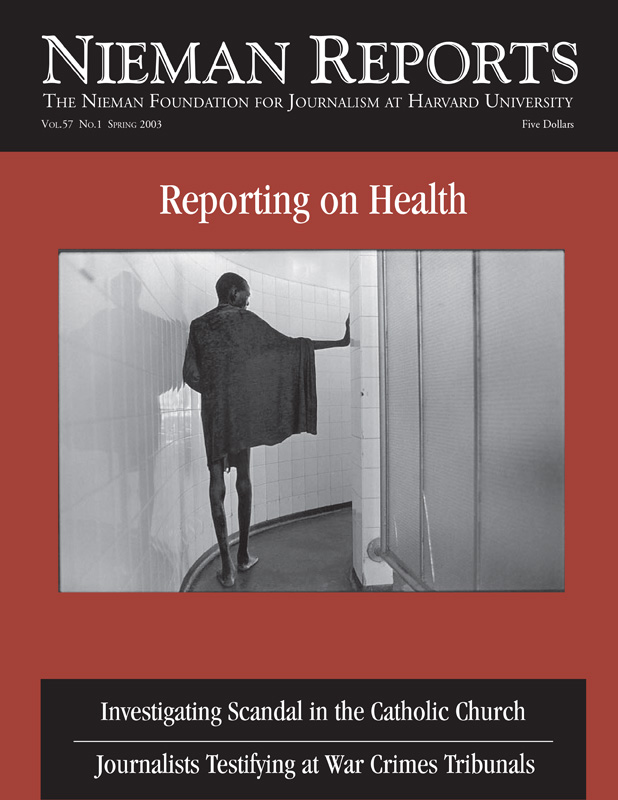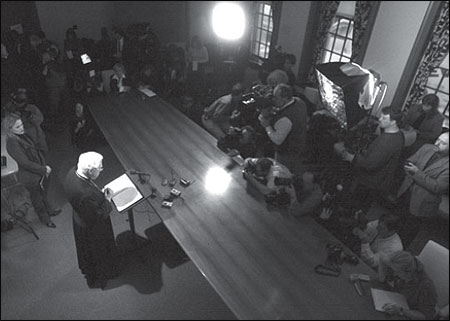
Reporting on Health
Few topics receive more media attention today than the topic of health. Yet, in the view of some journalists, many of the stories being told about health are not ones journalists want to tell or that members of the public need to hear. As Andrew Holtz, a freelance health reporter and president of the Association for Health Care Journalists, observes, “… stories I think need to be told, are often not the ones that easily sell. My personal frustration is not the issue, but we should be concerned when journalists are inhibited from the work of sustaining an informed and involved citizenry.” – Melissa Ludtke, Editor

The scarring of the faithful’s trust in the bishops of the Roman Catholic Church from the clergy abuse scandal has had a devastating effect on the church’s ability to raise money. From Sunday collection plates to the generous annual checks received from well-heeled business leaders and family foundations, there has been a precipitous decline in giving to the church. A Gallup poll in December found 40 percent of Catholics less likely to give to the church and its worthwhile missions because of their disappointment in the handling of the sexual abuse cases.
“It is clear that some people who have supported the Church’s work in past years are withholding, at least temporarily, their support financially due to their feelings regarding the terrible scandal of sexual abuse of the young by clergy,” David W. Smith, chancellor of the Archdiocese of Boston, said in a prepared statement in September. Smith, the chief financial officer for the archdiocese, said this as he announced the archdiocese’s decision to mortgage the 16-acre site of its chancery and the cardinal’s residence on the Boston-Newton line to borrow $38 million from the Knights of Columbus.
It was a surprising admission, since several months earlier Smith and other church leaders were denying that the scandal was having any significant effect on Sunday collections or larger donations. Regrettably, there was no way for journalists to document the accuracy of either of these claims.
Trying to Follow the Money
The Constitution’s First Amendment provides complete protection from state oversight to religious institutions. This means that even though the Catholic Church operates with a $45 million annual budget and owns an estimated $2 billion worth of real estate in eastern Massachusetts, the Boston archdiocese, like the 185 other dioceses and archdioceses in the United States, cannot be forced to make public any data on its financial condition.
When reporters at The Boston Globe went looking in customary places where such information on nonprofits is found—the state Attorney General’s charitable division of GuideStar.org, a national database—they learned nothacing. For an institution that had found ways to keep silent the complaints of more than 200 victims during one two-year period, who were molested by priests in the Boston area, the secrecy with which it maintained its financial dealings was not surprising. And this secrecy was maintained, even as the news of the priests’ sexual abuse and the church’s cover-up was published, and the financial impact of the scandal became an increasingly larger part of the story.
On the financial frontlines, several situations received considerable coverage:
- Boston Cardinal Bernard F. Law’s fiscal advisers rejected as too costly a settlement package for 86 victims of Rev. John J. Geoghan.
- The archdiocese’s two major insurance companies threatened to present legal defenses that would leave the church having to pay all of the $100-150 million in expected claims out of its own pocket.
- The Archdiocese took serious steps towards becoming the first Catholic organization in the United States to file for bankruptcy.
Yet each of these developments got into the paper only on the basis of information we gathered from informed sources. Unlike the Globe’s reporting on the priests’ sexual abuse and the Church’s attempts to keep that information hidden—in which documents were often made available by court order—these financial stories had to be published without any adequate documentary backup. This meant that with these financial aspects of this story, we weren’t able to give our readers—who were by now accustomed to us sharing with them the documents we’d found to substantiate our reporting—this level of detail.
The church did not begin to place a tight grip on its financial records with the clergy abuse scandal. To a great measure, the faithful have always been denied information about its finances. Two years before the scandal broke, I was focused on the personal and financial activities of a priest at one of the archdiocese’s largest parishes. In seven years as the church’s pastor, he had never provided the lay council that was appointed to advise him on financial issues any basic information, such as where he kept the parish’s bank accounts or even how much money was in the accounts. When a member of the church, a lawyer and certified public accountant, asked for an accounting, he was informed by the archdiocese that he had no standing to question the decision-making of the parish priest. The pastor is answerable only to the cardinal as bishop of the archdiocese, and he is answerable only to the pope.
The byzantine structure of the church and its hierarchical decisionmaking process on money issues complicated the task of reporters who became focused on the fiscal side of the scandal. Although public records show parish property to be listed in the name of the archbishop of Boston (as a “corporation sole”), through our reporting we discovered that there were limitations to this centralized power. Under canon law, the bishop or archbishop can sell a parish building or parcel only with the assent of the parish priest. This limitation left Cardinal Law with fewer options in settling the sexual abuse claims.
To document that the Church was losing money before the scandal broke, the archdiocese released copies of recent independent audits that showed it had sold $40 million in stocks and bonds to pay its bills. But when further questions were posed about the $600 million in assets maintained in separate insurance, health and pension accounts, the archdiocese refused journalists access to those audits.
We were also told that Cardinal Law had the sole authority to determine whether the archdiocese would approve a settlement. Yet, as the cardinal got ready to approve a deal that would have paid the 86 victims of former priest John Geoghan between $15 million to $30 million, reporters learned of the existence of an arcane group, the Archdiocesan Finance Council. This turned out to be a group of about 15 members comprised mostly of Catholic business leaders who provide financial advice to the cardinal.
Although they were appointed by the cardinal and serve at his leisure, when we made calls to several of them their responses revealed great unrest on whether the Geoghan settlement should be approved. In the end, Law’s request that the deal be signed was overwhelmingly rejected. But because the council’s sessions are shrouded in such secrecy—members don’t even know what’s on the agenda until a day or two before the meeting—those who were willing to share any information had to be given strict pledges of confidentiality.
This arrangement meant that when our reporting appeared in the paper, we could identify our sources only as “unnamed,” and could not even hint at their business affiliation. “I’ll not meet with you,” one member, who provided pieces of information along the way, told me. “If anyone ever asks me if I’ve ever spoken to you, I want to be able to say, ‘No, I’ve never met him.’”
Stephen Kurkjian has been working on the clergy abuse scandal for more than a year as a member of The Boston Globe’s Spotlight Team. A reporter and editor at the Globe for more than 30 years, he has specialized in local investigative and enterprise reporting. He currently holds the title of senior assistant metropolitan editor.


